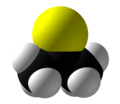Thioacetone
 | |||
| |||
| Names | |||
|---|---|---|---|
| IUPAC name
2-Propanethione | |||
| Identifiers | |||
| 4756-05-2 monomer 828-26-2 trimer | |||
| 3D model (Jmol) | Interactive image | ||
| ChemSpider | 557043 | ||
| PubChem | 641811 | ||
| |||
| |||
| Properties | |||
| C3H6S | |||
| Molar mass | 74.14 g·mol−1 | ||
| Appearance | Brown liquid | ||
| Melting point | 40 °C (104 °F; 313 K) | ||
| Boiling point | 80–90 °C (176–194 °F; 353–363 K) | ||
| Hazards | |||
| Main hazards | Odor, skin irritant | ||
| Except where otherwise noted, data are given for materials in their standard state (at 25 °C [77 °F], 100 kPa). | |||
| Infobox references | |||
Thioacetone is an organosulfur compound with the chemical formula (CH3)2CS. It is a lightly studied compound. The compound has been isolated as an orange or brown liquid at low temperatures.[1] Above -20 °C, thioacetone readily converts to a polymer and a trimer.[2]
Preparation
Thioacetone is usually obtained by cracking the cyclic trimer [(CH3)2CS]3. The trimer is prepared by pyrolysis of allyl isopropyl sulfide or by treating acetone with hydrogen sulfide in the presence of Lewis acids.[3][4] The trimer cracks at 500-600 °C to give the thione.[1][5]
Thioacetone trimer
The trimer of thioacetone is a white or colorless compound with a melting point of 24 °C, near room temperature. It also has a disagreeable odor.[2] It is also known as 1,1,3,3,5,5-hexamethyltrithiane. Taste at 0.35-0.50 ppm is recommended, its organoleptic characteristics are described as berry; earthy; minty; citrus; sulfurous.
Odor
Thioacetone has a foul odor. Like many low moleclar weight organosulfur compounds, the smell is potent. And like such compounds it can be detected at high dilution.[6] In 1889, an attempt to distill the chemical in the German city of Freiburg im Breisgau was followed by cases of vomiting, nausea and unconsciousness in an area of 0.75 kilometres (0.47 mi) around the laboratory due to the smell.[7] The soap manufacturer Whitehall Soap Works later noted in a 1890 report that dilution seemed to make the smell worse and described the smell as "fearful".[8]
See also
- Thiobenzophenone, a thioketone that can be isolated as a solid
References
- 1 2 V.C.E. Burnop; K.G. Latham (1967). "Polythioacetone Polymer". 8: 589–607. doi:10.1016/0032-3861(67)90069-9.
- 1 2 R. D. Lipscomb; W. H. Sharkey (1970). "Characterization and polymerization of thioacetone". Journal of Polymer Science Part A-1: Polymer Chemistry. 8 (8): 2187–2196. doi:10.1002/pol.1970.150080826.
- ↑ Bailey, William J.; Chu, Hilda (1965). "Synthesis of polythioacetone". ACS Polymer Preprints. 6: 145–155.
- ↑ Bohme, Horst; Pfeifer, Hans; Schneider, Erich (1942). "Dimeric thioketones". Berichte der Deutschen Chemischen Gesellschaft. 75B: 900–909. Note: This early report mistakes the trimer for the monomer
- ↑ Kroto, H. W.; Landsberg, B. M.; Suffolk, R. J.; Vodden, A (1974). "The photoelectron and microwave spectra of the unstable species thioacetaldehyde, CH3CHS, and thioacetone, (CH3)2CS". Chemical Physics Letters. 29: 265. doi:10.1016/0009-2614(74)85029-3.
- ↑ Derek Lowe (June 11, 2009). "Things I Won't Work With: Thioacetone". In The Pipeline.
- ↑ E. Baumann & E. Fromm (1889). "Ueber Thioderivate der Ketone". Berichte der deutschen chemischen Gesellschaft. 22 (2): 2592–2599. doi:10.1002/cber.188902202151.
- ↑ Chemical News and Journal of Industrial Science. 61: 209 https://books.google.ca/books?id=MSDOAAAAMAAJ&pg=RA3-PA6&lpg=RA3-PA6&dq=smell+thioacetone&source=bl&ots=X0UH-GWpAa&sig=5wmkE-x9ZTWlWq5mCb6aQ9Argvw&hl=en&ei=14IoSoXQAtuptgeX0-jWBQ&sa=X&oi=book_result&ct=result#v=onepage&q=smell%20thioacetone&f=false. Missing or empty
|title=(help)
External links
- Thioacetone, NIST
- Trithioacetone, Aldrich


